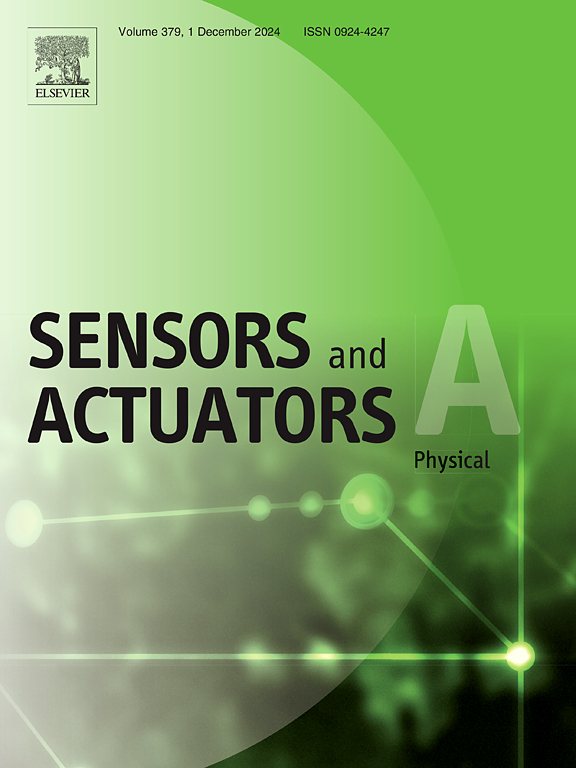An electrochemical velocity-type vector hydrophone for high-sensitivity underwater acoustic detection below 100 Hz
IF 4.1
3区 工程技术
Q2 ENGINEERING, ELECTRICAL & ELECTRONIC
引用次数: 0
Abstract
This paper presents an electrochemical velocity-type vector hydrophone designed for the direct detection of acoustic particle velocity. Compared to acceleration-type vector hydrophones, the proposed device demonstrates superior low-frequency sensitivity, effectively meeting the detection requirements for underwater acoustic signals below 100 Hz. A theoretical model was developed to analyze acoustic transmission characteristics and optimize the key parameters of the rubber membrane. The sensitive electrode chip, fabricated utilizing MEMS technology, integrates both cathode and anode electrodes separated by a 10 μm insulating spacer. The influence of different sensitive electrode configurations on the hydrophone’s frequency response characteristics was investigated using a water standing wave tube calibration system. Experimental results reveal that an electrode configuration with an 80 μm flow hole diameter exhibits optimal performance. Furthermore, a packaging design incorporating stabilized-flow channels was developed. Compared to conventional packaging, the proposed design with four stabilized-flow channels reduces the steady-state recovery time by 98 %. This design effectively isolates acoustic signals from fluid disturbance signals, significantly enhancing the hydrophone’s overload resistance in complex underwater environments. The hydrophone exhibits a flat amplitude-frequency response below 100 Hz, with a sensitivity of −172.6 dB at 5 Hz. It demonstrates good cosine directionality, with a concave point depth of −33.41 dB at 35 Hz. The device’s noise level was measured as 78.2 dB at 5 Hz on the bedrock of the seismic station. These characteristics highlight the hydrophone’s potential for detecting weak low-frequency underwater acoustic signals, making it well-suited for marine exploration applications.
用于100 Hz以下高灵敏度水声探测的电化学速度型矢量水听器
本文提出了一种电化学速度型矢量水听器,用于直接探测声粒子速度。与加速度型矢量水听器相比,该装置具有优越的低频灵敏度,可有效满足100 Hz以下水声信号的检测要求。建立了理论模型,分析了橡胶膜的声传输特性,并对其关键参数进行了优化。该敏感电极芯片采用MEMS技术制造,阴极和阳极电极由10 μm绝缘间隔层分开。利用驻波管定标系统,研究了不同敏感电极配置对水听器频率响应特性的影响。实验结果表明,流孔直径为80 μm的电极结构性能最佳。此外,还开发了一种包含稳定流动通道的包装设计。与传统包装相比,采用四个稳定流动通道的设计可将稳态恢复时间缩短98% %。该设计有效地隔离了声信号和流体干扰信号,显著提高了水听器在复杂水下环境中的抗过载能力。该水听器在100 Hz以下表现出平坦的幅频响应,在5 Hz时灵敏度为- 172.6 dB。它表现出良好的余弦方向性,在35 Hz下凹点深度为−33.41 dB。该装置在地震台基岩上以5 Hz的频率测量出的噪声级为78.2 dB。这些特点突出了水听器在探测微弱低频水声信号方面的潜力,使其非常适合海洋勘探应用。
本文章由计算机程序翻译,如有差异,请以英文原文为准。
求助全文
约1分钟内获得全文
求助全文
来源期刊

Sensors and Actuators A-physical
工程技术-工程:电子与电气
CiteScore
8.10
自引率
6.50%
发文量
630
审稿时长
49 days
期刊介绍:
Sensors and Actuators A: Physical brings together multidisciplinary interests in one journal entirely devoted to disseminating information on all aspects of research and development of solid-state devices for transducing physical signals. Sensors and Actuators A: Physical regularly publishes original papers, letters to the Editors and from time to time invited review articles within the following device areas:
• Fundamentals and Physics, such as: classification of effects, physical effects, measurement theory, modelling of sensors, measurement standards, measurement errors, units and constants, time and frequency measurement. Modeling papers should bring new modeling techniques to the field and be supported by experimental results.
• Materials and their Processing, such as: piezoelectric materials, polymers, metal oxides, III-V and II-VI semiconductors, thick and thin films, optical glass fibres, amorphous, polycrystalline and monocrystalline silicon.
• Optoelectronic sensors, such as: photovoltaic diodes, photoconductors, photodiodes, phototransistors, positron-sensitive photodetectors, optoisolators, photodiode arrays, charge-coupled devices, light-emitting diodes, injection lasers and liquid-crystal displays.
• Mechanical sensors, such as: metallic, thin-film and semiconductor strain gauges, diffused silicon pressure sensors, silicon accelerometers, solid-state displacement transducers, piezo junction devices, piezoelectric field-effect transducers (PiFETs), tunnel-diode strain sensors, surface acoustic wave devices, silicon micromechanical switches, solid-state flow meters and electronic flow controllers.
Etc...
 求助内容:
求助内容: 应助结果提醒方式:
应助结果提醒方式:


